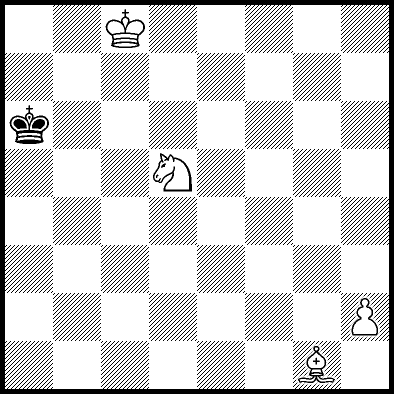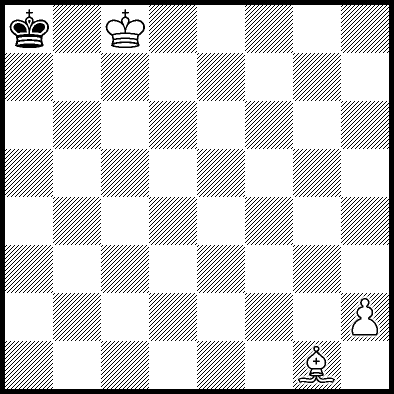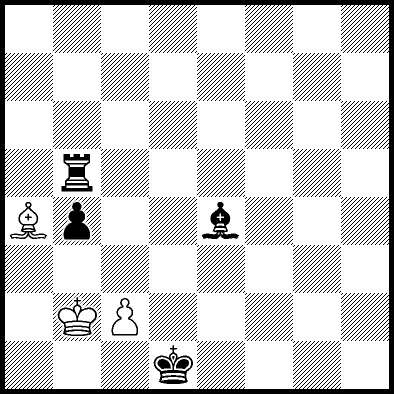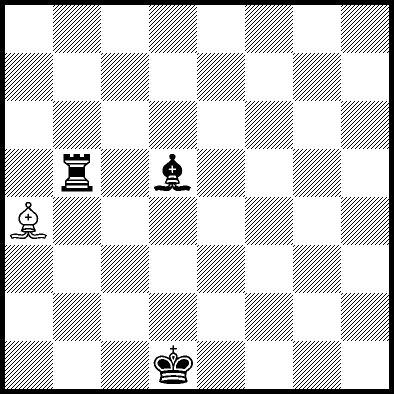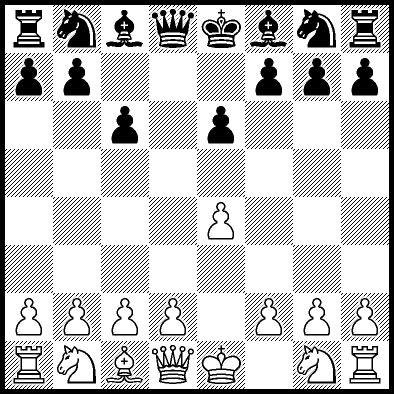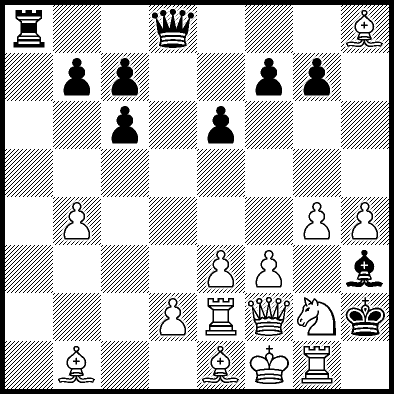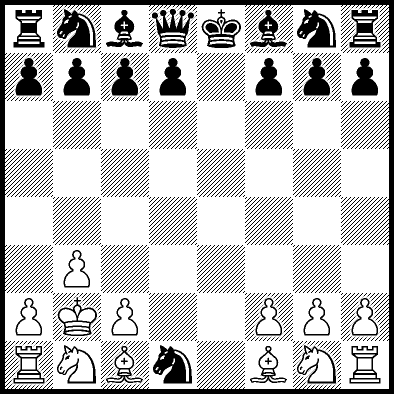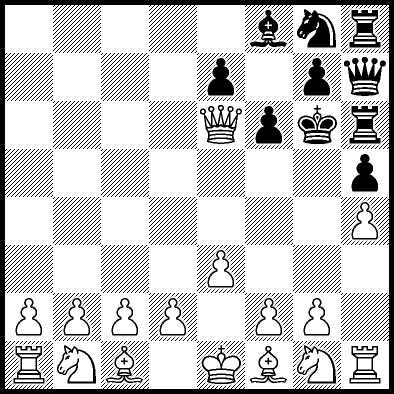Chess Problem Solutions

| 1. |
Rhg7 |
| 1. |
... |
Kc8 |
|
1. |
... |
Ke8 |
|
1. |
... |
Nb7 |
|
1. |
... |
Nf7 |
|
1. |
... |
Ne8 |
|
1. |
... |
Nc8 |
| 2. |
Ra8# |
|
|
2. |
Rg8# |
|
|
2. |
Ra8# |
|
|
2. |
Rg8# |
|
|
2. |
Ra8# |
|
|
2. |
Rg8# |
|
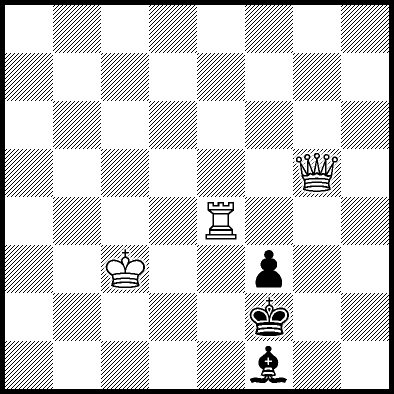
| 1. |
Re1 |
| 1. |
... |
Kxe1 |
|
1. |
... |
Bg2 |
|
1. |
... |
B~ |
| 2. |
Qd2# |
|
|
2. |
Qh4# |
|
|
2. |
Qg1# |
|
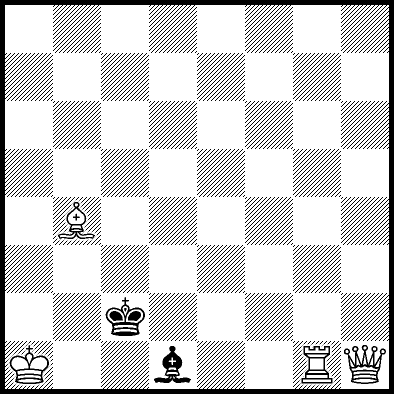
| 1. |
Rg4 |
| 1. |
... |
Kc1 |
|
1. |
... |
Kb3 |
|
1. |
... |
Kd3 |
|
1. |
... |
B~ |
| 2. |
Rc4# |
|
|
2. |
Qxd1# |
|
|
2. |
Qe4# |
|
|
2. |
Qb1# |
|
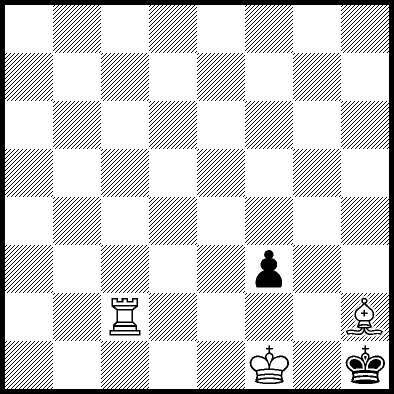
| 1. |
Bb8 |
f2 |
| 2. |
Rc7 |
Kh2 |
| 3. |
Rh7# |
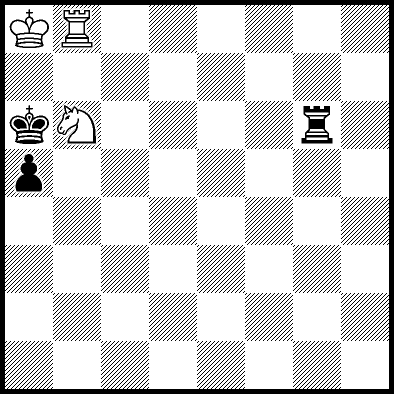
| 1. |
Nd5 |
|
(threatening 2. Nc7#) |
| 1. |
... |
Rg7 |
|
1. |
... |
a4 |
|
1. |
... |
Rc6 |
| 2. |
Rb6# |
|
|
2. |
Nc7+ |
Ka5 |
|
2. |
Rb6+ |
Rxb6 |
|
|
|
|
3. |
Rb5# |
|
|
3. |
Nc7# |
|
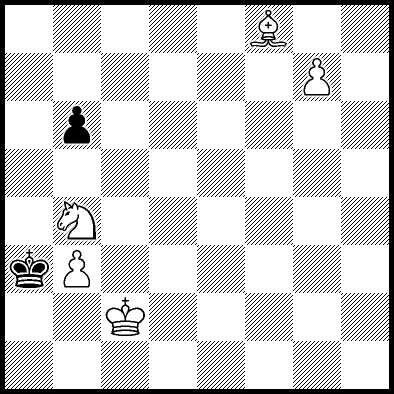
| 1. |
g8=N |
b5 |
| 2. |
Ne7 |
Kxb4 |
| 3. |
Nc6# |
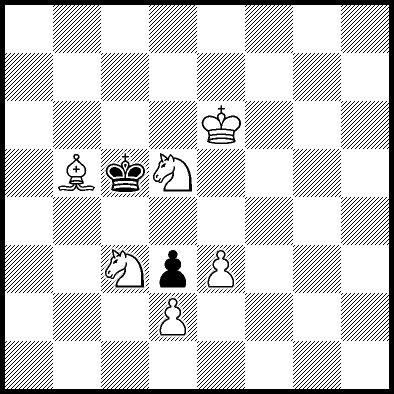
| 1. |
Kf5 |
Kd6 |
| 2. |
Ne4+ |
Kxd5 |
| 3. |
Kf6 |
Kxe4 |
| 4. |
Bc6# |

| 1. |
Ba3 |
b4 |
| 2. |
Bbd4 |
bxa3 |
| 3. |
Ba1 |
a2 |
| 4. |
Kc3 |
Kxa1 |
| 5. |
Kc2# |
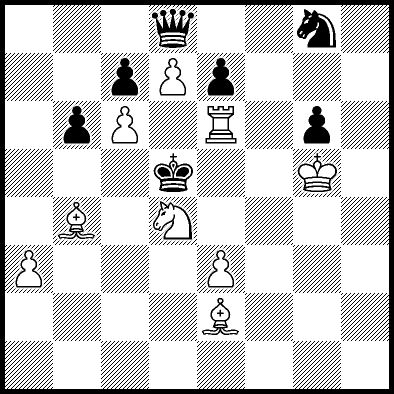
| 1. |
Bd1 |
|
(threatening 2. Bb3#) |
| 1. |
... |
Kc4 |
| 2. |
Bb3+ |
Kd3 |
| 3. |
Ba4 |
|
(threatening 4. Bb5#) |
| 3. |
... |
Kc4 |
| 4. |
Bb5+ |
Kd5 |
| 5. |
Nf3 |
|
(threatening 6. Re5#) |
| 5. |
... |
Kxe6 |
| 6. |
Bc4# |

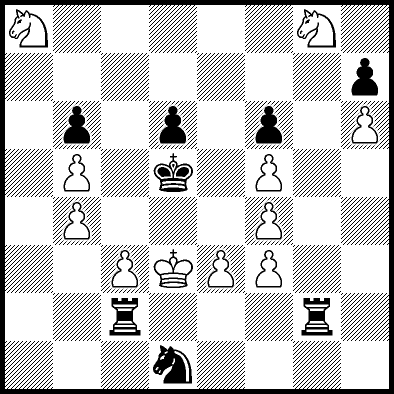
| 1. |
c4+ |
Rxc4 |
| 2. |
e4+ |
Rxe4 |
| 3. |
Ne7+ |
Rxe7 |
| 4. |
Nc7+ |
Rxc7 |
stalemate |
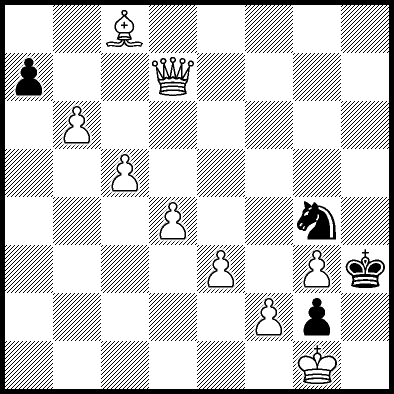
| 1. |
Ba6 |
ab |
| 2. |
Bb5 |
bc |
| 3. |
Bc4 |
cd |
| 4. |
Bd3 |
de |
| 5. |
Be2 |
ef# |
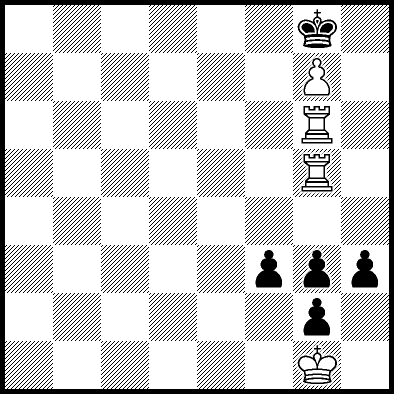
| 1. |
Re5 |
Kf7 or Kh7 |
| 2. |
g8=R |
f2# or h2# |
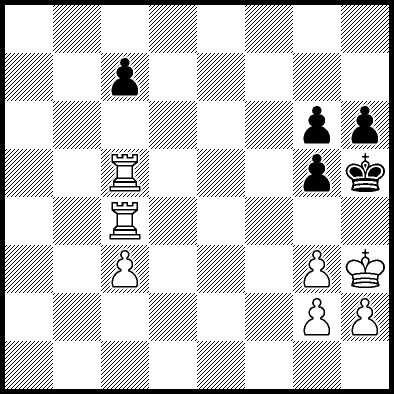
| 1. |
Ra4 |
c6 |
| 2. |
Ra5 |
c5 |
| 3. |
c4 |
g4# |
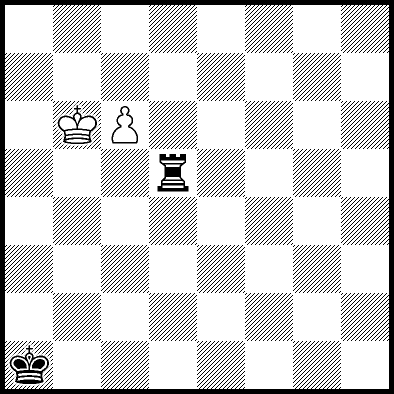
| 1. |
c7 |
Rd6+ |
| 2. |
Kb5 |
Rd5+ |
(if 2. Kb7 Rd7, and if 2. Kc5 Rd1 3. c8=Q Rc1+) |
| 3. |
Kb4 |
Rd4+ |
| 4. |
Kc3 |
Rd1 |
| 5. |
Kc2 |
Rd4 |
| 6. |
c8=R |
Ra4 |
(if 6. c8=Q Rd4+ 7. Qxd4 stalemate) |
| 7. |
Kb3 |
|
(threatening both 8. Kxa4 and 8. Rc1#) |
|
1 - 0 |
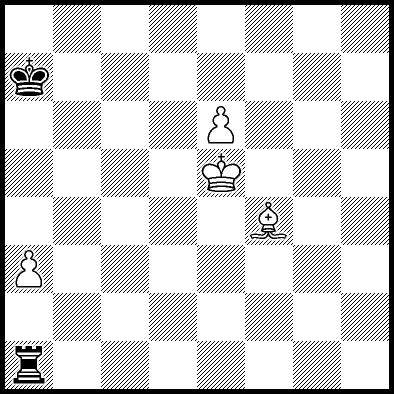
| 1. |
Be3+ |
Kb7 |
| 2. |
e7 |
Rxa3 |
| 3. |
Ba7 |
Ra1 |
| 4. |
Kf4 |
Rf1+ |
| 5. |
Bf2 |
Rxf2+ |
| 6. |
Ke3 |
Rf1 |
| 7. |
Ke2 |
|
(and the pawn promotes) |
|
1 - 0 |
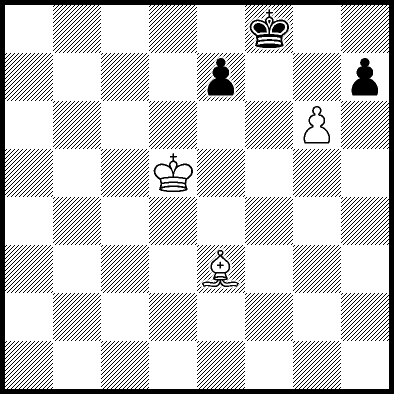
| 1. |
Bh6+ |
Kg8 |
| 2. |
g7 |
|
| 2. |
... |
e5 |
|
2. |
... |
e6 |
|
2. |
... |
Kf7 |
| 3. |
Ke6 |
e4 |
|
3. |
Kd6 |
Kf7 |
|
3. |
g8=Q+ |
Kxg8 |
| 4. |
Kf6 |
e3 |
|
4. |
Ke5 |
Kg8 |
|
4. |
Ke6 |
Kh8 |
| 5. |
Bxe3 |
|
|
5. |
Kf6 |
|
|
5. |
Kf7 |
e6/e5 |
|
1 - 0 |
|
|
1 - 0 |
|
6. |
Bg7# |
|
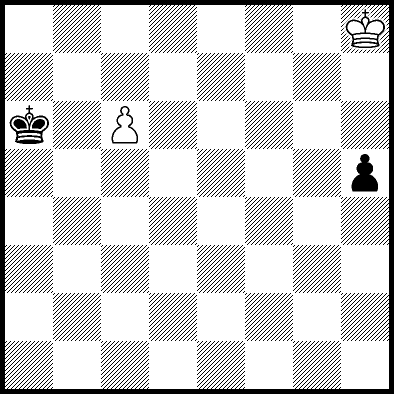
| 1. |
Kg7 |
h4 |
| 2. |
Kf6 |
|
| 2. |
... |
h3 |
|
2. |
... |
Kb6 |
| 3. |
Ke6 |
h2 |
|
3. |
Ke5 |
| 3. |
c7 |
Kb7 |
|
3. |
... |
h3 |
|
3. |
... |
Kxc6 |
| 4. |
Kd7 |
|
|
4. |
Kd6 |
h2 |
|
4. |
Kf4 |
h3 |
|
½ - ½ |
|
4. |
c7 |
|
|
4. |
Kg3 |
|
|
|
|
|
|
½ - ½ |
|
|
½ - ½ |
|
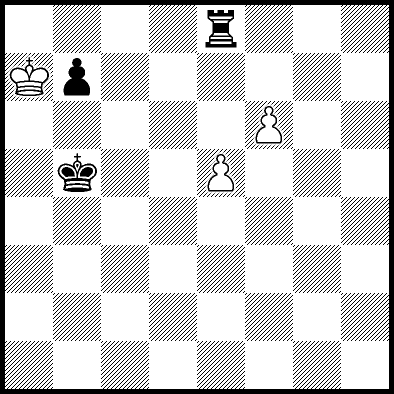
| 1. |
f7 |
Rf8 |
| 2. |
e6 |
b6 |
| 3. |
Kb7 |
Kc5 |
(if 3. e7 Rxf7 and the e-pawn is pinned) |
| 4. |
e7 |
Rxf7 |
| 5. |
Ka6 |
Rxe7 |
stalemate |
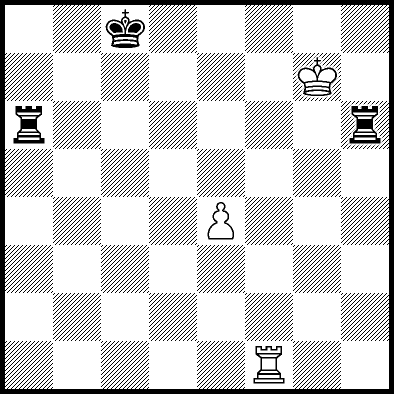
| 1. |
Rf8+ |
Kd7 |
| 2. |
Rf7+ |
Ke6 |
| 3. |
Rf5 |
|
|
½ - ½ |
If black moves away his attacked rook he loses the other one with
Rf6+, and if his king retreats to the 7th rank white checks as
before.
Answer: c3
| 1. |
Kb3 |
Bd5+ |
| 2. |
c4 |
dc+ |
| 3. |
Kxc3+ |
|
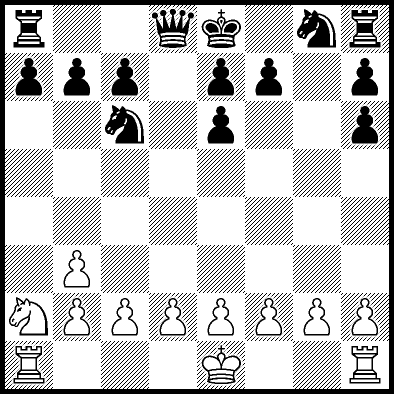
Answer: h6
Proof
- First consider which white pieces were captured on e6 and h6. The
bishops never moved (look at the pawns), so it must have been the
queen and the missing knight.
- Next consider which black piece was captured on b3. Only the
bishops are missing, and so it must have been the white-squared
bishop.
- Finally consider the order in which these captures occurred. The
first capture must have been the white knight on either e6 or h6. But
if it was on h6, how could the white-squared bishop get out to b3? So
it must have been e6, and therefore the white queen must have fallen
on h6.
| 1. |
Nf3 |
e5 |
| 2. |
Nxe5 |
Ne7 |
| 3. |
Nxd7 |
Nc6 |
| 4. |
Nxb8 |
Nxb8 |
| 1. |
e4 |
e6 |
| 2. |
Bb5 |
Ke7 |
| 3. |
Bxd7 |
c6 |
| 4. |
Be8 |
Kxe8 |
| 1. |
Nc3 |
d5 |
| 2. |
Nxd5 |
g6 |
| 3. |
Nxe7 |
Nf6 |
| 4. |
Nxg6 |
Ne4 |
| 5. |
Nxh8 |
Nc3 |
| 6. |
Nxf7 |
Qg5 |
| 7. |
Nxg5 |
Nb1 |
| 8. |
Nxh7 |
Bd7 |
|
|
| 9. |
Nxf8 |
c6 |
| 10. |
Nxd7 |
b5 |
| 11. |
Nxb8 |
Kf7 |
| 12. |
Nxc6 |
Kg6 |
| 13. |
Nxa7 |
Kh5 |
| 14. |
Nxb5 |
Ra3 |
| 15. |
Nxa3 |
Kh4 |
| 16. |
Nxb1 |
|
|
Proof Game
| 1. |
Nf3 |
Nf6 |
| 2. |
Ne5 |
Nd5 |
| 3. |
Ng6 |
Nb4 |
| 4. |
Nxf8 |
Nxa2 |
| 5. |
Ng6 |
Nb4 |
| 6. |
Ne5 |
o-o |
| 7. |
g3 |
Nd3+ |
| 8. |
cd |
a5 |
| 9. |
b4 |
a4 |
| 10. |
Nc3 |
a3 |
|
|
| 11. |
Bb2 |
a2 |
| 12. |
Rc1 |
a1=Q |
| 13. |
Bh3 |
Na6 |
| 14. |
Be6 |
Nc5 |
| 15. |
Nf3 |
Qa5 |
| 16. |
Ba2 |
Ne4 |
| 17. |
de |
Qf5 |
| 18. |
ef |
Ra6 |
| 19. |
h4 |
Rg6 |
| 20. |
fg |
Re8 |
|
|
| 21. |
gh+ |
Kf8 |
| 22. |
h8=B |
Kg8 |
| 23. |
Kf1 |
Kh7 |
| 24. |
Kg1 |
Kg6 |
| 25. |
Nd5 |
Kh5 |
| 26. |
Bd4 |
Kg4 |
| 27. |
Nh2+ |
Kh3 |
| 28. |
f3 |
Rf8 |
| 29. |
Ne3 |
Re8 |
| 30. |
Ng2 |
Rf8 |
|
|
| 31. |
Bf2 |
Re8 |
| 32. |
Qf1 |
Rf8 |
| 33. |
e3 |
Re8 |
| 34. |
Re1 |
Rf8 |
| 35. |
Re2 |
Re8 |
| 36. |
Be1 |
Rf8 |
| 37. |
Qf2 |
Re8 |
| 38. |
Kf1 |
Rf8 |
| 39. |
Rg1 |
Re8 |
| 40. |
Ng4 |
Rf8 |
|
|
| 41. |
Ne5 |
Kh2 |
| 42. |
Nc6 |
dc |
| 43. |
Bb3 |
Bh3 |
| 44. |
g4 |
Qd7 |
| 45. |
Ba2 |
Ra8 |
| 46. |
Bb1 |
Qd8 |
|
Description
The wBh8 requires wPc2xd3xe4xf5xg6xh7-h8=B, consuming all missing
black units except black-squared bBf8. Then the bPa7 had to be
promoted before it can be captured. So that a wP (a or b) had to be
captured to open the way (and no 2nd white promotion is possible). The
other missing white unit is a wN, captured by d7xNc6. bPh7 cannot have
been promoted, so that it has been captured at home.
The S-E corner unlocks by (1) retracting wPg3-g4, then (2)
extracting the bBh3, then (3) retracting bKh3-h2, then (4) inserting
something on h2 and (5) retracting Rh1-g1. Then everything unlocks.
But only a wN can reach h2 for step (4). This wN must be resurrected
on c6, after bBc8 is driven back home (requiring that e7-e6 is taken
back).
Now we see that the bK had to leave the 8th rank before d7xc6 or
e7-e6 took place. He had to go through the h7 hole, when there was a
promoted wBh8. Necessarily, the bKR was still there (so that the bQR
has been captured) and it could only let the bK out if the first move
of the bK was O-O. (The bR now on a8 is the original bKR, the bKB was
captured at home, the wPa2 was captured on its file).
| 1. |
d4 |
e5 |
| 2. |
Kd2 |
ed |
| 3. |
b3 |
d3 |
| 4. |
Kc3 |
de |
| 5. |
Kb2 |
exd1=N# |
| 1. |
e3 |
a5 |
| 2. |
Qh5 |
Ra6 |
| 3. |
Qxa5 |
h5 |
| 4. |
Qxc7 |
Rah6 |
| 5. |
h4 |
f6 |
| 6. |
Qxd7+ |
Kf7 |
| 7. |
Qxb7 |
Qd3 |
| 8. |
Qxb8 |
Qh7 |
| 9. |
Qxc8 |
Kg6 |
| 10. |
Qe6 |
|
stalemate |

